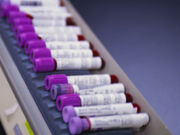Initial specimen diversion device reduces blood culture contamination without impacting sensitivity
MONDAY, May 22, 2017 (HealthDay News) — For patients undergoing blood cultures in an emergency department setting, use of a device that diverts and sequesters the initial 1.5 to 2.0 mL of blood (initial specimen diversion device [ISDD]) is associated with a decrease in blood culture contamination, according to a study published online May 17 in Clinical Infectious Diseases.
Mark E. Rupp, M.D., from the University of Nebraska Medical Center in Omaha, and colleagues conducted a prospective controlled trial comparing ISDD with standard phlebotomy procedures for patients with clinical suspicion of serious infection. Data were included for 904 nonduplicative subjects with 1,808 blood cultures.
The researchers found that, compared with the standard procedures, blood culture contamination was significantly reduced through use of the ISDD (0.22 versus 1.78 percent, respectively; P = 0.001). There was no compromise in sensitivity: true bacteremia was seen in 7.2 and 7.6 percent of samples using the ISDD and standard procedure, respectively (P = 0.41). There were no reports of needlestick injury or potential bloodborne pathogen exposure. Comparing the six-month after with before intervention periods, phlebotomists using the ISDD experienced a significant decrease in blood culture contamination, while nurses not using the ISDD did not. There was widespread user satisfaction among the 73 percent of phlebotomists who completed a post-study anonymous survey.
“Use of the ISDD was associated with a significant decrease in blood culture contamination in patients undergoing blood cultures in an emergency department setting,” the authors write.
The study was funded by Magnolia Medical Technologies, which manufactures the ISDD used in the study; one author disclosed financial ties to 3M.
Copyright © 2017 HealthDay. All rights reserved.








